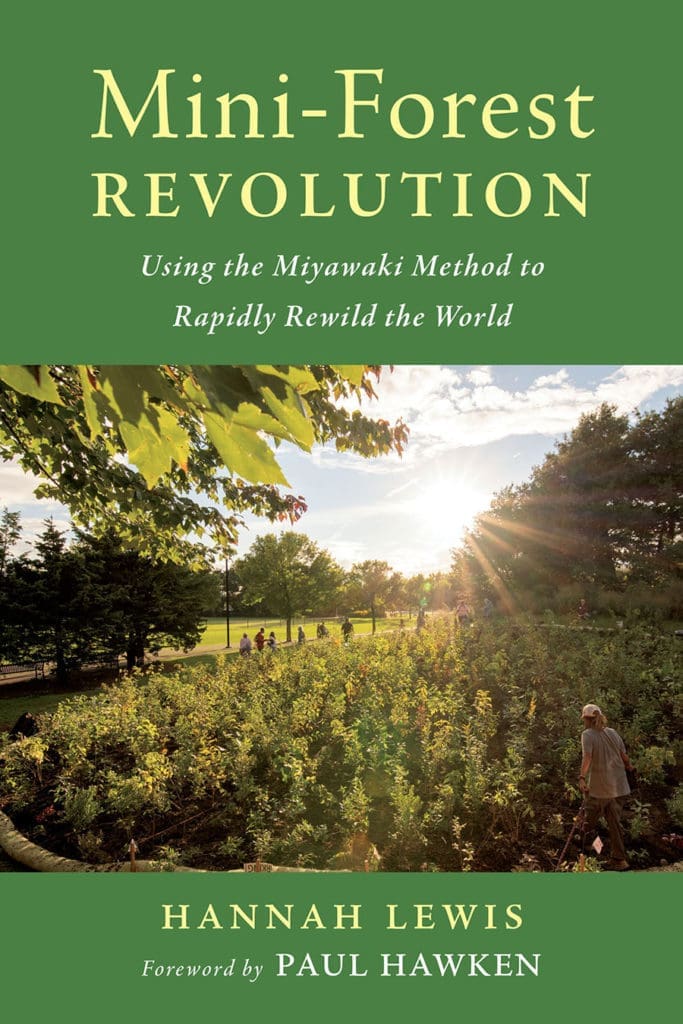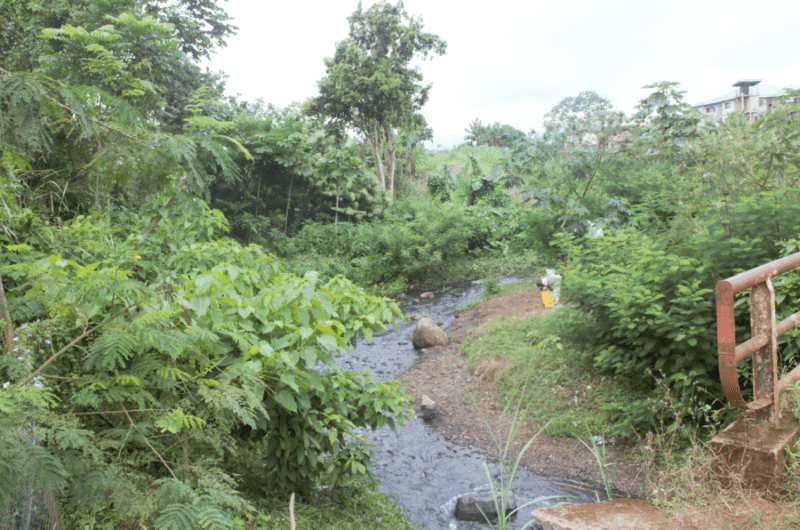Bulu mini-forest in Cameroon after 19 months; Photo: Agborkang Godfred
Hannah Lewis, Compendium Editor for Biodiversity for a Liveable Climate and freelance writer
The Miyawaki Method
The Miyawaki Method is a way to grow natural, mature forests in a couple of decades rather than a couple of centuries. You do this by observing what happens in nature. When bare ground is left undisturbed for many decades or centuries, plants grow into the space in successive waves of increasingly larger, longer-living, and more shade-tolerant vegetation, each group replacing the previous group. This process ultimately results in a stable, mature forest in places where the climate is suitable for such. The Miyawaki Method anticipates what would grow in that ultimate forest community and plants those species directly.
In addition to guiding the choice of species – which will include not only large canopy trees but also smaller trees and shrubs, the Miyawaki Method calls for intensively preparing the soil, planting densely, heavily mulching, and actively maintaining the site for the first three years as the forest becomes established. By the end of three years, the young trees will have formed a thick enough canopy to shade out weeds and create a microclimate that protects the soil. So, by this time a forest planted this way is self-sufficient, needing no further maintenance.
Community engagement is a core element of the Miyawaki Method. Dr. Miyawaki himself organized “planting festivals” for forest making that very deliberately put communities at the center of the process. These festivals got started with a call-and-response “naming ceremony” in which everyone gathered would call out and repeat the names of the main tree species they were about to plant – to learn the names and be able to recognize the species. In his prolific writing and speaking, Miyawaki made it clear that people are a part of nature, that our wellbeing depends on the wellbeing of ecosystems, and that we have a responsibility toward one another to take care of nature. So, naturally, people should be involved in forest-making.
The method lends itself to intergenerational public participation because the plants are small, lightweight, and easy to plant even for a small child. Also, because there are so many plants, it takes a lot of people to get the job done!

Photo: Ethan Bryson of Natural Urban Forests
Mini-Forest Revolution
My motivation to write Mini-Forest Revolution and to plant a mini-forest were inseparable from each other, and similar to what motivated the others featured in the book to embrace the Miyawaki Method. For me, it has been a positive way to transform anxiety over our languishing planet, over all the species being lost, and over all the individuals suffering – into action that can slow those processes down, at least locally. Planting a mini-forest is a way to express love for this world, and writing the book seemed like a good way to explain how and why. And both projects were a lot of fun!
My goal for the book is to encourage readers to reconsider our relationship to wildlife by more clearly seeing our interdependence with other species. While we can probably survive without cell phones, cars, and refrigerators, we cannot live too long without the web of relationships that results in oxygen production, clean water, healthful food, and milder weather patterns. Planting mini-forests is a way to nurture a section of the greater web of life, which in turn supports our lives in more ways that we can imagine through interdependencies to which we are generally blind. There are millions of examples of species interactions happening outside the human realm that sustain us – and forests are the site of many such interactions. Let’s conserve and restore forests together.

Tania Roa, Digital Communications and Internships Manager for Bio4Climate
In “Mini-Forest Revolution,” Hannah Lewis outlines a replicable, evidently successful urban afforestation method. She not only makes it easy for us readers to understand the Miyawaki Method, she gives us the knowledge and tools to plant our own mini-forests. This book does three things: bring awareness to the connections between climate change and biodiversity loss, emphasize nature’s solutions to these intertwined crises, and give us a call to action – all in 205 pages.
The idea of planting a small forest may seem counterintuitive. You might be thinking, “Don’t we need larger forests? How can a mini forest tackle global warming and biodiversity loss on a large scale?” These are valid questions.
When we think of the climate crisis, we think of a global phenomenon, and that leads us to think we need to invest in cross-continental solutions. But what if we thought global and acted local? We would still be aiming to address the issues that affect people across the globe, but we would be doing it in a way that allows us to start anywhere, anytime. You most likely don’t have the resources and connections to begin a project that reaches dozens of countries at once, but you do have the means to create a positive impact right in your own neighborhood. That may not make a difference to someone living oceans away, but it will change the lives of the people, wildlife, and soil microorganisms around you.
Hannah also points out that in just a few years, the number of Miyawaki forests around the world has expanded more than Dr. Miyawaki himself could have predicted. One man, with a dedication to leaving the world better than he found it, came up with an idea that transformed how we think about ecosystems in urban settings. If there was ever proof that the actions of one person can influence the actions of another, even for those who never had the honor of meeting him, it’s in the life of Akira Miyawaki.
For me, the most important aspect of the Miyawaki Method is the community-led mindset. Planting Miyawaki forests is not meant to be done by one person. This model is designed to incorporate as many people in the vicinity as possible. It’s meant to be shared, and with that the benefits of the forest are replicated. By involving local communities, you inevitably spread the message of nature’s climate solutions, the benefits of biodiversity, and the fact that humans are inextricably linked to other species. Embedded in this method is education, inspiration, and ultimately positive action.
So if you ever feel like the climate action you’re taking is not enough, just remember what a wise person once said: a small act is not so small if millions of people are doing it. Every revolution needs to start somewhere. Every revolution needs masses of people to get informed, join, and take a leap of faith. The mini-forest revolution is underway – will you be a part of it?
To learn more about the Miyawaki Method and Hannah’s book “Mini-Forest Revolution,” click below to watch the interview I hosted, and get ready to be inspired!


























